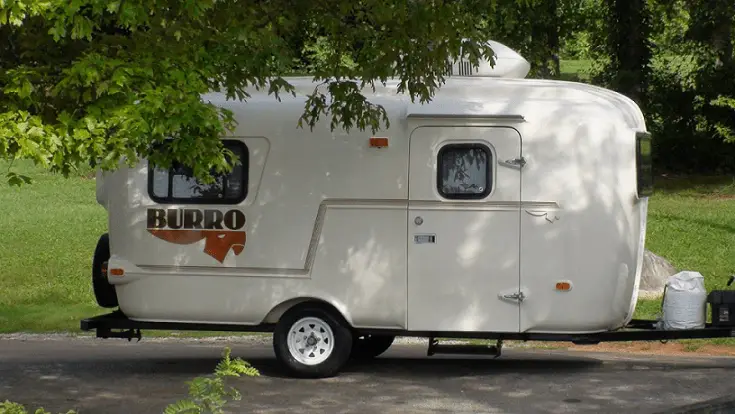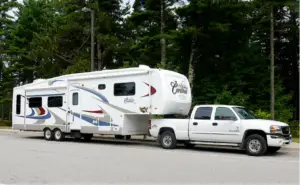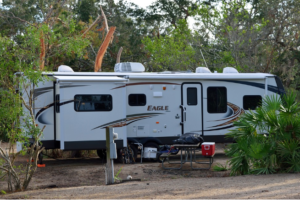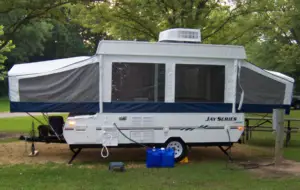Regular maintenance can keep your RV roof in excellent condition. But, without knowing what it’s made of, you might not be able to maintain it properly.
In this article, we will explore the different options of RV roofing as well as the various ways of identifying if your RV roof is made of fiberglass, and what it takes to maintain it.
Understanding fiberglass RV roof
Fiberglass creates an auxiliary roof using a blend of synthetic materials and glass fibers established in individual sheets or large panels. Typically, it consists of fiber-reinforced plastic coated in a colored or clear gel resin.
The gel coating usually preserves the surface of the RV and offers a glossy appearance. However, exposure to moisture and heat can oxidize the gel causing the RV to appear dull and faded.
Typically, fiberglass comes in various styles and hence can be challenging to identify at first glance.
Here are key things that tell if your RV roof is fiberglass:
- Fiberglass RV roof is lighter than aluminum and solid but not metallic.
- You can recognize fiberglass roof by its hardness.
- It does not flex like the aluminum roof, but it feels different than a rubber roof (hard to touch).
- Fiberglass roof is very smooth and can be dangerously slippery when wet.
- Fiberglass is the most expensive among the RV roofs.
pros and cons of fiberglass RV roof
The pros:
- Low risk of cracks and damage, which translates to durability
- It is lightweight than aluminum
- Easily customizable to complement your RV in color, shape, and patterns
- Compared to rubber, fiberglass RV roofs require minimal maintenance
- It is fire-resistant, rot-proof, and rust-resistant
- Higher resale value than aluminum model
The cons:
- Fiberglass roofs are expensive to install and repair when damaged
- They’re not ideal for large roofs because of their expansion rate
Types of RV Roofing Material
To successfully tell if your RV roof is fiberglass, you should know what other types of roofs are available and how to identify them. Here are the most common ones:
Rubber RV roof
The rubber roof is available in two types – TPO (Thermal Poly Olefin) RV roof and EPDM (Ethylene Propylene Diene Monomer) RV roof. Rubber roof is the only type that is soft.
Most new rubber roofs are white, while older ones might be tan and off-white in color. Besides, rubber roofs are smooth but it may have a chalky texture as it starts wearing down.
Aluminum RV roof
Aluminum RV roofs are a rare variety that is commonly found in Vintage RVs. They have a shiny silver metallic look and are hardy, resilient, durable, and require low maintenance. However, the Aluminum roof is expensive to install and might add unwanted weight to your RV.
Vinyl (PVC) RV roof
Vinyl usually resembles rubber roofs in look and feel. But, should you try to pinch it, it won’t pinch up. Vinyl RV roofs are strong, durable, and environmentally friendly. However, old or damaged vinyl is challenging to repair. Besides, vinyl is not cold-hardy and might fail during the cold seasons.
Fiberglass roof
This type of RV roof consists of reinforced plastic of textile fiber coated in a colored or clear gel resin. There are lighter, hard to the touch, long-lasting, incredibly resistant to damage, and require less maintenance than rubber RV roofs making them a preferred option for many.
Fiberglass Roof Maintenance
RV fiberglass roof needs proper maintenance to keep it from leaking and look sleek. With proper maintenance fiberglass RV roof can last between 15 to 20 years. In comparison to other RV roof materials, fiberglass requires less maintenance.
Normally, a hard fiberglass roof does not leak easily unless there is physical damage to it. While working on the roof to install air conditioner, antenna or vents, holes cracks may start which can lead to water leaks.
Below maintenance tips will help you enjoy a leak-free and dazzling RV:
Proper storage
How you store the RV in the off-season can affect the level of deterioration the fiberglass roof sustains. Indoor storage is ideal as nothing can protect your RV roof better than another roof.
If a garage is not available, but protect the RV with a cover. If you leave your RV uncovered under the trees, chances are the roof will collect catkins, bird droppings, sap, and other falling debris that makes cleaning a challenge. Also, direct heat or moisture exposure will accelerate oxidation.
Regular cleaning
It is essential to clean your RV roof twice a year. But, if the RV is more susceptible to dirt and debris, you should do so every three months. The longer you wait the more accumulated muck there will be to wash.
To clean a fiberglass roof, first, sweep off the surface to remove any buildup and rinse it with a hose. Apply a cleaning substance in small sections (most RVers rely on a granular powdered product to clean fiberglass roofs) and scrub with a soft-bristled brush. For stubborn stains, you can use the Fiberglass Stain remover.
Fiberglass Roof Protection
After cleaning the roof, it’ll need a protectant to prevent oxidation and black streaks from forming on the walls. The protectant will also restore the shiny luster of the fiberglass RV roof. If little oxidation is present, apply a restorer/wax or cleaner/wax to buff it out to a nice shine.
Bonus tips:
- Waxing once a year can keep the roof gel coat strong and prolong the fiberglass lifespan
- Be careful when walking on waxed fiberglass RV roofs, particularly when wet, as it can be dangerously slippery
Watch out for the cracks
While cleaning the fiberglass RV roof, you should also check for any weak points where water can infiltrate. The sooner you identify them, the lesser your chances of having a leaky roof and water damage.
Check for any tearing or cracks in the seal, particularly on the caulking around skylights and vents. If you notice signs of wear, reseal them by placing drops of caulk down the crack.
Ideally, RV roofs including fiberglass type should be resealed once every year. Do a visual inspect before and after every trip. Check seals around AC, vents or other items like solar panels and satellite antenna.
Walking on fiberglass roof : Though they are hard and strong enough, one has to be careful while walking due to its slippery nature.
Conclusion
While identifying if your RV roof is fiberglass can be challenging, doing so ensures that you can clean and maintain it appropriately. Remember that the RV allows you to live a life of freedom and adventure, but that’ll only last long if your roof is well kept. So, identify your roof material, keep it clean, maintain, repair, and it’ll serve you right.





